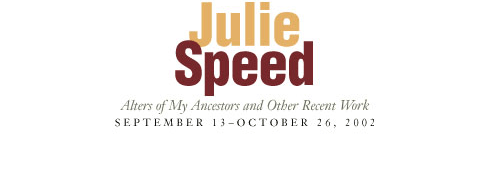


Julie Speed: An Irreverent Eye
Finely-crafted visual puzzles—metaphoric expressions, if you like, for her cynicism, wit, and even at times iconoclasm about life and people.
While these words characterize the special qualities of Julie Speed's masterful collages known as The Alters of My Ancestors, the same qualities inform her recent paintings, twelve of which are featured in the current exhibition at Pillsbury and Peters Fine Art. The most important difference between the two groups lies, of course, in the medium. Whereas the collages rely upon found or appropriated images, the paintings derive solely from the artist's imagination, exploiting the artist's uncanny gift for realistic depiction.
Ironically, the more accurate and faithful the record of a given place or thing—in a word the better the illusion—the more artificial the representation becomes. Salvador Dalí understood this paradox and created a memorable body of work to take advantage of the dichotomy. Recent photography is another example. Liberated from its journalistic function, digital photography has become an artful medium of seemingly limitless manipulation and transformation. Julie Speed accomplishes the same goal, but with an innocence that borders on naďvété and an irreverence that makes life—and even art—a diabolical comedy of manners (no pun intended!).
Nothing Julie Speed paints is what it seems. In The Dogmatists she recreates an arm-wrestling match between two determined contestants. Given the bombardment of explosive comets falling upon the shoulders of the oblivious combatants and the fanciful ecclesiastical garments which serve as their uniforms, the picture seems less about athletic machismo than the folly of fanaticism, supporting the artist's conviction that zealots ruin the world for everyone.
The same kind of iconoclasm prevails in Watchdog, a fearsome portrait of a grimacing man in military regalia who shouts in anger. The painting defies the rules of portraiture by virtue of the expression, and one is obliged to see in the picture a metaphor of the ambivalent role of guardians as agents for both good and evil. An open mouth is the principal dramatic element in another recent painting, and again there is a suggestion of menace. In this work entitled The Voice of Dog, a cardinal sits in profile looking heavenward while the fearsome animal seated on his lap bares his fangs. The juxtaposition of a church official and his growling companion is unsettling. Are we to conclude that the authority to enforce its doctrines and protect its followers requires the Church to make use of fear and intimidation?
The message of Boning the Fish and All That Remains is unmistakable. In the former, a bishop and a cleric contend for the right to devour a sliced fish. In the latter the world is in flames as figures gather in a stark interior at a table bearing "all that remains"—an overturned pitcher and cup as well as scattered animal bones. The expressions of the cardinal and seated woman are ones of disbelief; the suppliant young boy is masked.
Julie Speed's work is not only portentious, but it is also on occasion elegiac. In Damage a woman casts her eyes upon the viewer with a rueful expression as burning bodies cascade from the sky—a literal reference to the unforgettable horror of September 11. In Twins one sister engages the viewer, while her sibling averts the viewer's glance. The doubling of heads parallels the artist's addition of a third eye on her people and animals. In Annunciation the artist portrays a forlorn creature holding a lily isolated in a sea of sperm. On her head there is no halo, rather a frog snaring a spermatozoa with his extended tongue. The painting refers to pregnancy but its interpretation is elusive. No meaning attaches to the frog but its presence suggests a surrogate for the handsome young prince the lady yearns to meet and with whom she will one day procreate. The amphibious reptile creates an impression of incongruity.
In Julie Speed's paintings everything appears real, but on more careful inspection there is something unfamiliar, if not odd, whether a burning body, a third eye, a glance, or a perched frog. Her paintings offer infinite possibilities. Whereas her collages and sculptures assembled from pre-existing parts are exercises in surrealism, the paintings supercede realism; they are, in the artist's own vernacular, para-realistic.
Edmund P. Pillsbury, Ph.D.

